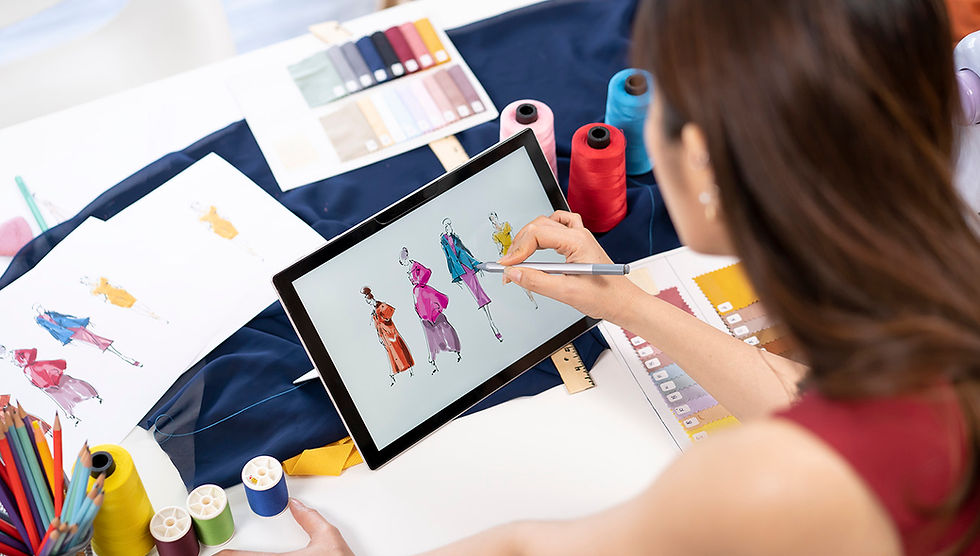INSIDE THE FASHION INDUSTRY - How to Build a Sustainable Fashion Brand on a Budget during Tariffs
- Barbara Sessim

- Aug 20
- 4 min read

Ok ok ok… escaping the topic of tariffs has been difficult, yet there is undeniable value to be explored within it! To connect two of today’s most relevant conversations, and ensure they resonate with my main focus: emerging designers, let’s examine tariffs and sustainability through the lens of building a brand on a budget.
In today’s fashion landscape, building a sustainable fashion brand on a budget during tariffs has become one of the biggest challenges for emerging designers. With shifting trade policies and rising import costs, designers must rethink how to balance sustainability with financial constraints. This goes far beyond material choices, it includes production practices, mindful MOQs, branding, marketing, and even how profits are reinvested into communities and sustainable causes.
1. Materials Are Just the Starting Point
Using eco-friendly or upcycled materials establishes a foundation, but true sustainability requires attention across your operations. Consider Priya Ahluwalia, a London-based designer who builds her collections using deadstock and vintage textiles, interweaving storytelling, heritage, and sustainable production. She has even partnered with Microsoft to launch Circulate, a web app encouraging clothing donations for upcycling creating a circular fashion cycle Teen Vogue.
Another example is Marine Serre, whose brand integrates upcycled and recycled materials into around 50% of her collections, embracing circularity and regeneration at the heart of her design process Marine Serre.
2. Production Practices and Mindful MOQs
Large Minimum Order Quantities (MOQs) often force emerging brands into overproduction or stretched budgets. Thankfully, new platforms now offer sustainable fabric sourcing at lower MOQs making ecological textiles accessible even to small labels Barbara Sessim. This shift enables designers to stay agile, minimize waste, and keep cash flow healthy without compromising on quality.
PS: Yup! Using myself as a source because I have accumulated SO much informative content about this that you all should be familiar with by now…
3. Navigating Tariff Pressures with Strategy
Tariffs, recently introduced as high as 125% on Chinese imports, have disrupted indie designers’ supply chains, squeezing margins and complicating international trade Ahluwalia+1. Independent, women-led brands are being forced to rethink sourcing, pricing, and production strategies. Experts advise against using tariffs as a reason to abandon sustainability; instead, consider long-term investments in thoughtful practices that preserve both values and viability.
In light of this, emerging designers can:
Prioritize nearshoring or domestic production when possible to avoid tariffs and simplify logistics.
Offer smaller, curated drops instead of large seasonal collections.
Elevate supply chain integrity, like ethical manufacturing and decarbonization, over chasing the trendiest sustainable materials.
4. Branding and Marketing That Align with Values
A strong narrative rooted in transparency, craftsmanship, and purpose can deeply resonate with eco-conscious consumers. Many CFDA/Vogue Fashion Fund finalists of 2025 are redefining what it means to be sustainable - focusing on self-funding, craftsmanship, and inclusive storytelling VogueGQ.
Similarly, Fashion Council Germany’s Fashion x Craft programme has equipped emerging designers with circular design skills, such as basket weaving and embroidery - merging tradition, sustainability, and innovation GQFashion Tech News.
5. Giving Back Through Community and Profit Strategy
Sustainability extends beyond manufacturing; it’s also about how a brand reinvests in people and causes. Impact can take many forms:
Reinvesting a portion of profits into environmental causes or local communities.
Building a brand community through shared values and open communication.
Collaborating with artisans or supporting cultural heritage crafts.
For instance, Ahluwalia’s Circulate initiative not only reduces waste, it also taps into cultural traditions of handing down clothing, fostering deeper consumer engagement and social impact Teen Vogue.
Marine Serre has also used exhibitions and pop-ups to involve her audience directly, such as hosting a free exhibition of her creative process and donating proceeds to support Ukrainian refugees Vogue Business.
PS: another great example of a brand that does an amazing job on giving back to the community is WeWoreWhat, Founded by the influencer Danielle Bernstein. She created a non-profit called WeGaveWhat which is focused on raising funds and donating portions of her profits to communities in need around the world.
Emerging Designers Leading the Way
Priya Ahluwalia: London-based designer using deadstock and vintage fabrics, enriching fashion with culture and sustainability. Her Circulate web app in collaboration with Microsoft exemplifies innovation in circular fashion Teen Vogue.
Marine Serre: French designer whose brand uses approximately 50% upcycled materials and prioritizes circular design. Her approach models how luxury fashion can be regenerative and inclusive Marine Serre, Vogue Business+1.
CFDA/Vogue Fashion Fund 2025 Finalists: Independent designers emphasizing sustainability, cultural craft, and pioneering business models VogueGQ.
Fashion Council Germany’s Fashion x Craft Participants: Designers building circular collections from heritage textiles and craft techniques Fashion Tech NewsGQ.
Creating a sustainable fashion brand on a budget amid tariff pressures requires creativity, intentional decisions, and community focus. It’s about more than materials, it’s about production choices, flexible MOQs, thoughtful branding, strategic giving, and creative reinvention.
I have helped many emerging designers build business plans tailored to their unique needs, including integrating sustainable practices. To learn more, schedule a free 30-minute strategy call with me here:







Comments